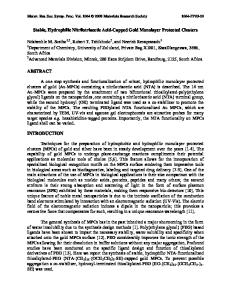Gold nanoparticle-glutathione-functionalized porous graphene oxide-based hydrophilic beads for the selective enrichment
- PDF / 1,871,841 Bytes
- 10 Pages / 595.276 x 790.866 pts Page_size
- 114 Downloads / 281 Views
ORIGINAL PAPER
Gold nanoparticle-glutathione-functionalized porous graphene oxide-based hydrophilic beads for the selective enrichment of N-linked glycopeptides Jie Li 1
1
& Weiwei Huan &
Kaiwei Xu 2 & Buchuan Wang 1 & Jingshu Zhang 3 & Binbin Zhu 2 & Minjie Wu 1 & Jianhua Wang 2
Received: 3 May 2020 / Accepted: 18 August 2020 # Springer-Verlag GmbH Austria, part of Springer Nature 2020
Abstract A three-dimensional structured porous graphene oxide-polyethylenimine bead (pGP) is synthesized for immobilizing gold nanoparticles and modifying glutathione molecules (denoted as pGP/AuG). The pGP/AuG has open pore structure, honeycomb-like channels, and excellent hydrophilicity. By taking advantages of the porous structure, abundant binding sites, and multivalent interactions between glycopeptides and both glutathione molecules and free amino groups, the pGP/AuG is adopted to the selective enrichment of N-linked glycopeptides with low limit of detection (2 fmol), high enrichment selectivity (1:500), binding capacity (333.3 mg/g), recovery yield (91.3 ± 2.1%), and repeatability (< 6.0% RSD) using matrix-assisted laser desorption/ionization time of flight mass spectrometry detection method. Furthermore, the practical applicability of pGP/AuG is evaluated, in which 209 N-glycosylated peptides corresponding to 128 N-glycosylated proteins are identified from 1 μL human serum in three independent analysis procedures, suggesting the great potential for application in glycoproteome fields. Keywords Graphene oxide . Zwitterionic molecule . Porous bead . Glycopeptide enrichment . Human serum
Introduction As one of the most ubiquitous and complex post-translational modifications, protein glycosylation plays indispensable roles in many cell biology processes [1]. Aberrant protein glycosylation has been proven to associate with many human diseases [2]. The comprehensive identification of glycoproteins Electronic supplementary material The online version of this article (https://doi.org/10.1007/s00604-020-04519-w) contains supplementary material, which is available to authorized users. * Jie Li [email protected] * Jianhua Wang [email protected] 1
Zhejiang Provincial Key Laboratory of Chemical Utilization of Forestry Biomass, Zhejiang A& F University, Lin’an, Hangzhou 311300, China
2
Department of Radiology, The Affiliated Hospital of Medical School of Ningbo University, Ningbo 315020, China
3
Safety Assessment and Research Center for Drug, Pesticide and Veterinary Drug of Jiangsu Province, Nanjing Medical University, Nanjing 211166, China
contributes to understand their biological functions and discover clinical biomarkers. Mass spectrometry (MS) has become a most effective tool in proteomic research [3]. However, some challenges still existed in MS-based glycoproteomics analysis: the low abundance of glycopeptides/glycoproteins, the inherently inhomogeneous glycans, and the serious ion suppression of non-glycopeptides [4, 5]. As a consequence, it is highly imperative to develop the sample enrichment technologies for selecti
Data Loading...











